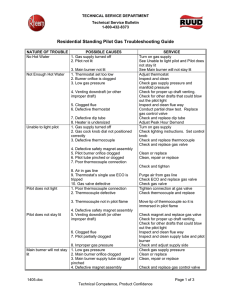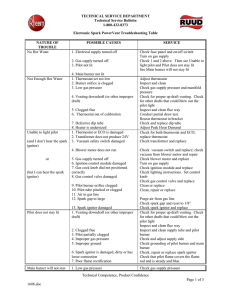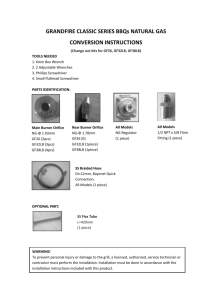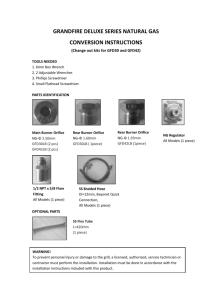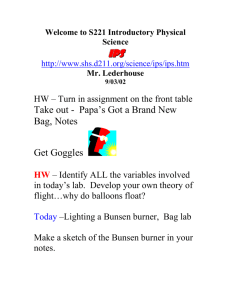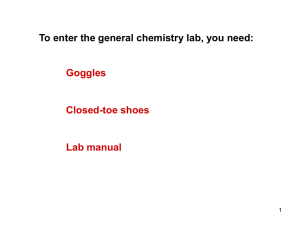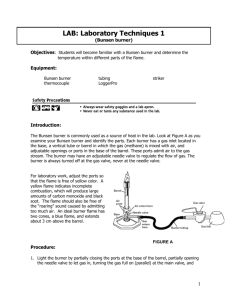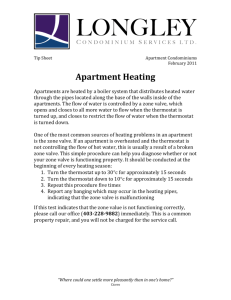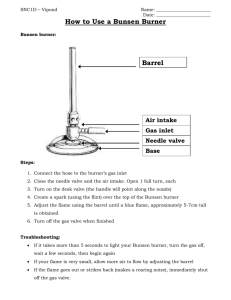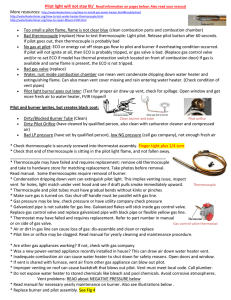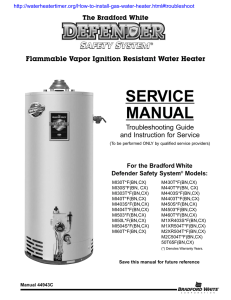Residential Standing Pilot Gas Troubleshooting Guide
advertisement
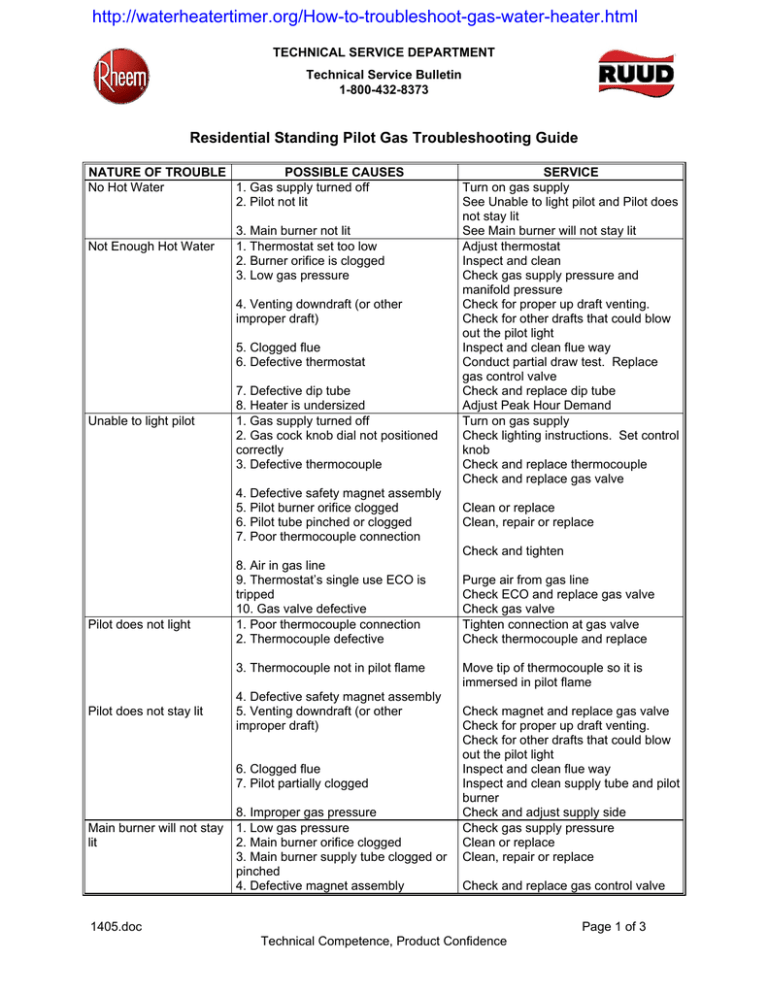
http://waterheatertimer.org/How-to-troubleshoot-gas-water-heater.html TECHNICAL SERVICE DEPARTMENT Technical Service Bulletin 1-800-432-8373 Residential Standing Pilot Gas Troubleshooting Guide NATURE OF TROUBLE POSSIBLE CAUSES No Hot Water 1. Gas supply turned off 2. Pilot not lit Not Enough Hot Water 3. Main burner not lit 1. Thermostat set too low 2. Burner orifice is clogged 3. Low gas pressure 4. Venting downdraft (or other improper draft) 5. Clogged flue 6. Defective thermostat Unable to light pilot 7. Defective dip tube 8. Heater is undersized 1. Gas supply turned off 2. Gas cock knob dial not positioned correctly 3. Defective thermocouple 4. Defective safety magnet assembly 5. Pilot burner orifice clogged 6. Pilot tube pinched or clogged 7. Poor thermocouple connection SERVICE Turn on gas supply See Unable to light pilot and Pilot does not stay lit See Main burner will not stay lit Adjust thermostat Inspect and clean Check gas supply pressure and manifold pressure Check for proper up draft venting. Check for other drafts that could blow out the pilot light Inspect and clean flue way Conduct partial draw test. Replace gas control valve Check and replace dip tube Adjust Peak Hour Demand Turn on gas supply Check lighting instructions. Set control knob Check and replace thermocouple Check and replace gas valve Clean or replace Clean, repair or replace Check and tighten Pilot does not light 8. Air in gas line 9. Thermostat’s single use ECO is tripped 10. Gas valve defective 1. Poor thermocouple connection 2. Thermocouple defective 3. Thermocouple not in pilot flame Pilot does not stay lit 4. Defective safety magnet assembly 5. Venting downdraft (or other improper draft) 6. Clogged flue 7. Pilot partially clogged 8. Improper gas pressure Main burner will not stay 1. Low gas pressure lit 2. Main burner orifice clogged 3. Main burner supply tube clogged or pinched 4. Defective magnet assembly Purge air from gas line Check ECO and replace gas valve Check gas valve Tighten connection at gas valve Check thermocouple and replace Move tip of thermocouple so it is immersed in pilot flame Check magnet and replace gas valve Check for proper up draft venting. Check for other drafts that could blow out the pilot light Inspect and clean flue way Inspect and clean supply tube and pilot burner Check and adjust supply side Check gas supply pressure Clean or replace Clean, repair or replace Check and replace gas control valve 1405.doc Page 1 of 3 Technical Competence, Product Confidence TECHNICAL SERVICE DEPARTMENT Scale on burner and pilot assemblies Sooting Yellow flame Burner flame noisy (whistling) Burner flame floats Burner flame too high Water too hot (followed by pilot outage) Slow hot water recovery Noisy water heater (rumbling and sizzling) Excessive relief valve operation Technical Service Bulletin 1-800-432-8373 5. Defective thermocouple Check and replace thermocouple 6. Poor thermocouple connection Inspect and tighten 7. Defective main valve Replace gas control valve 8. Improper venting Check venting for proper sizing and down drafts 1. Condensation Excessive condensation caused by undersized heater, poor venting or continued use 2. Contaminated atmosphere Check for contaminant causing chemicals near the heater 1. Combustion air inlets or flueway is Remove obstruction or debris from restricted heater or flueway 2. Not enough combustion or Improve combustion air or ventilation ventilation air supplied to room air supply 3. Improper gas pressure Check and adjust 4. Burner orifice dirty Inspect and clean 1. Scale on top of burner Shut off heater; allow to cool; clean burner plate 2. Burner orifice dirty Inspect and clean 3. Flue way clogged Inspect and clean 4. Improper gas pressure Check and adjust 1. Improper gas pressure Check and adjust 2. Burner orifice dirty Inspect and clean 1. Improper gas pressure Check and adjust 2. Wrong orifice Install correct orifice 3. Clogged flue Inspect and clean flue way 1. Improper gas pressure Check and adjust 2. Wrong orifice Install correct orifice 1. Thermostat setting too high Adjust thermostat to lower setting Check and replace thermostat 2. Thermostat out of calibration 1. Burner orifice clogged 2. Excessive drafts 3. Clogged flue 4. Improper gas pressure 1. Scale or sediment build up in bottom of tank 2. Baffles loose 3. Condensation on main burner 1. Excessive water pressure 2. Excessive temperature Rusty or black water 1. Anode rod dissolved 2. Excessive sediment build-up Water heater is leaking 1. Cold in or hot out joints 2. T&P valve (Gas water heaters produce condensation Check and clean Locate and eliminate drafts Clean flue chamber Check and adjust Clean tank Reset and tighten Inspect for condensation (normal) and tank leaks Install proper pressure reducing valve on cold side Check for open or closed system. Install expansion tank. Check thermostat; lower setting or replace Check anode rod and replace Drain tank; replace tank if sediment build up is excessive Check joint and repair Check valve and replace (Caution: Do not confuse normal T&P operation as a leaking tank. If the 1405.doc Page 2 of 3 Technical Competence, Product Confidence TECHNICAL SERVICE DEPARTMENT Technical Service Bulletin 1-800-432-8373 that may drip on the floor. 3. Immersion thermostat or anode rod is loose 4. Inner tank has a pin hole Smelly water (rotten egg Bacteria formation inside water tank odor) Milky water Aerated water puddle dries up, then look for a T&P problem.) Check, tighten and replace Replace water heater Clean tank using chlorine bleach Replace anode rod if deteriorated Add automatic chlorine feeder to cold water inlet side of tank Allow a glass of hot water to set for a few minutes. If the water turns clear, the condition is a natural occurrence. See water chemistry section. 1405.doc Page 3 of 3 Technical Competence, Product Confidence
